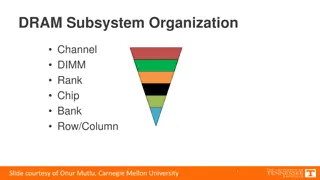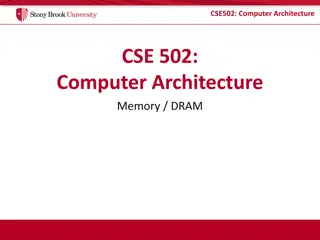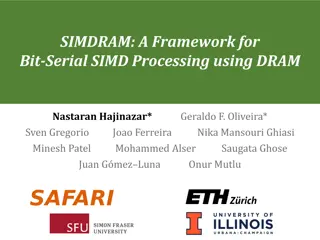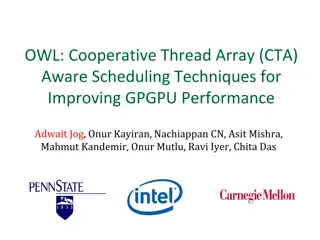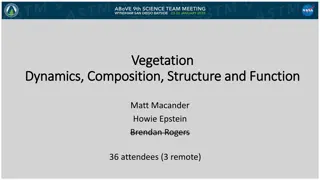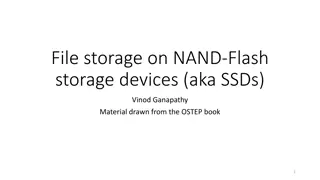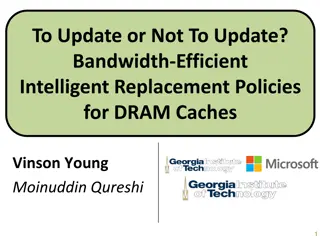Understanding RowPress: A New Read Disturbance Phenomenon in Modern DRAM Chips
Demonstrating and analyzing RowPress, a novel read disturbance phenomenon causing bitflips in DRAM chips. Different from RowHammer vulnerability, RowPress showcases effective solutions on real Intel systems with DRAM chips.
Download Presentation

Please find below an Image/Link to download the presentation.
The content on the website is provided AS IS for your information and personal use only. It may not be sold, licensed, or shared on other websites without obtaining consent from the author. Download presentation by click this link. If you encounter any issues during the download, it is possible that the publisher has removed the file from their server.
E N D
Presentation Transcript
RowPress Amplifying Read Disturbance in Modern DRAM Chips Haocong Luo Ataberk Olgun A. Giray Ya l k Yahya Can Tu rul Steve Rhyner Meryem Banu Cavlak Mohammad Sadrosadati Onur Mutlu Jo l Lindegger
High-Level Summary We demonstrate and analyze RowPress,a new read disturbance phenomenon that causes bitflips in real DRAM chips We show that RowPress is different from the RowHammer vulnerability We demonstrate RowPress using a user-level program on a real Intel system with real DRAM chips We provide effective solutions to RowPress 2
Outline DRAM Background What is RowPress? Real DRAM Chip Characterization Characterization Methodology Key Characteristics of RowPress Real-System Demonstration Mitigating RowPress Conclusion
DRAM Organization DRAM is the prevalent technology for main memory A DRAM cell stores 1 bit of information in a leaky capacitor DRAM cells are organized into DRAM rows DRAM Row Wordline 4
Read Disturbance in DRAM Read disturbance in DRAM breaks memory isolation Prominent example: RowHammer DRAM Chip Row 1 Row 1 Row 1 Victim Row open closed open open closed Aggressor Row Row 2 Row 2 Row 2 Row 2 Row 2 Row 2 Victim Row Row 3 Row 3 Row 3 Repeatedly opening (activating) and closing a DRAM row many times causes RowHammer bitflips in adjacent rows 5
Are There Other Read-Disturb Issues in DRAM? RowHammer is the only studied read-disturb phenomenon Mitigations work by detecting high row activation count What if there is another read-disturb phenomenon that does NOT rely on high row activation count? https://www.reddit.com/r/CrappyDesign/comments/arw0q8/now_this_this_is_poor_fencing/ 6
Outline DRAM Background What is RowPress? Real DRAM Chip Characterization Characterization Methodology Key Characteristics of RowPress Real-System Demonstration Mitigating RowPress Conclusion
What is RowPress? Keeping a DRAM row open for a long time causes bitflips in adjacent rows These bitflips do NOT require many row activations Only one activation is enough in some cases! Now, let s see how this is different from RowHammer 8
RowPress vs. RowHammer Instead of using a high activation count, increase the time that the aggressor row stays open Open RowHammer Aggressor Row Close 36ns, 47K activations to induce bitflips Open RowPress Aggressor Row Close 7.8 s, only 5K activations to induce bitflips We observe bitflips even with ONLY ONE activation in extreme cases where the row stays open for 30ms 9
Outline DRAM Background What is RowPress? Real DRAM Chip Characterization Characterization Methodology Key Characteristics of RowPress Real-System Demonstration Mitigating RowPress Conclusion
Major Takeaways from Real DRAM Chips RowPress significantly amplifiesDRAM s vulnerability to read disturbance RowPress has a different underlying failure mechanism from RowHammer 11
Outline DRAM Background What is RowPress? Real DRAM Chip Characterization Characterization Methodology Key Characteristics of RowPress Real-System Demonstration Mitigating RowPress Conclusion
Characterization Methodology (I) FPGA-based DDR4 testing infrastructure Developed from SoftMC [Hassan+, HPCA 17] and DRAM Bender [Olgun+, TCAD 23] Fine-grained control over DRAM commands, timings, and temperature 13
Characterization Methodology (II) DRAM chips tested 164 DDR4 chips from all 3 major DRAM manufacturers Covers different die densities and revisions 14
Characterization Methodology (III) Metric: The minimum number of aggressor row activations in total to cause at least one bitflip (ACmin) Access Pattern: Single-sided (i.e., only one aggressor row). Sweep aggressor row on time (tAggON) from 36ns to 30ms Data Pattern: Checkerboard (0xAA in aggressor and 0x55 in victim) Temperature: 50 C Algorithm: Bisection-based ACmin search Each search iteration is capped at 60ms (<64ms refresh window) Repeat 5 times and report the minimum ACmin value observed Sample 3072 DRAM rows per chip [More sensitivity studies in the paper] 15
Outline DRAM Background What is RowPress? Real DRAM Chip Characterization Characterization Methodology Key Characteristics of RowPress Real-System Demonstration Mitigating RowPress Conclusion
Major Takeaways from Real DRAM Chips RowPress significantly amplifiesDRAM s vulnerability to read disturbance RowPress has a different underlying failure mechanism from RowHammer 17
Key Characteristics of RowPress Amplifying read disturbance in DRAM Reduces the minimum number of row activations needed to induce a bitflip (ACmin) by 1-2 orders of magnitude In extreme cases, activating a row only once induces bitflips Gets worse as temperature increases Different from RowHammer Affects a different set of cells compared to RowHammer and retention failures Behaves differently as access pattern or temperature changes compared to RowHammer 18
Key Characteristics of RowPress Amplifying read disturbance in DRAM Reduces the minimum number of row activations needed to induce a bitflip (ACmin) by 1-2 orders of magnitude In extreme cases, activating a row only once induces bitflips Gets worse as temperature increases Different from RowHammer Affects a different set of cells compared to RowHammer and retention failures Behaves differently as access pattern or temperature changes compared to RowHammer 19
Amplifying Read Disturbance (I) How minimum activation count to induce a bitflip (ACmin) changes as aggressor row on time (tAggON) increases RowPress RowHammer 9x tREFI tREFI [min, max] ACmin = 1 20
Amplifying Read Disturbance (II) How minimum activation count to induce a bitflip (ACmin) changes as aggressor row on time (tAggON) increases RowPress RowHammer 21
Amplifying Read Disturbance (III) How minimum activation count to induce a bitflip (ACmin) changes as aggressor row on time (tAggON) increases ACmin reduces by 21X on average when tAggON increases from 36ns to 7.8 s 191X 70.2 s RowPress significantly reduces ACmin as tAggON increases 22
Amplifying Read Disturbance (IV) ACmin @ 80 Cnormalized to ACmin @ 50 C Data point below 1 means fewer activations to cause bitflips @ 80 C compared to 50 C When tAggON is 7.8 s, RowPress requires about 50% fewer activations to induce bitflips at 80 C compared to 50 C RowPress gets worse as temperature increases 23
Key Characteristics of RowPress Amplifying read disturbance in DRAM Reduces the minimum number of row activations needed to induce a bitflip (ACmin) by 1-2 orders of magnitude In extreme cases, activating a row only once induces bitflips Gets worse as temperature increases Different from RowHammer Affects a different set of cells compared to RowHammer and retention failures Behaves differently as access pattern or temperature changes compared to RowHammer 24
Difference Between RowPress and RowHammer (I) Cells vulnerable to RowPress vs. RowHammer Cells vulnerable to RowPress (RowHammer) are those that flip @ ACmin Overlap = ?????? ?? ????? ?????????? ?? ??? ???????? ??? ????????? ?????? ?? ????? ?????????? ?? ???????? On average, only 0.013% of DRAM cells vulnerable to RowPress are also vulnerable to RowHammer, when tAggON 7.8us 25
Difference Between RowPress and RowHammer (II) Cells vulnerable to RowPress vs. RowHammer Cells vulnerable to RowPress (RowHammer) are those that flip @ ACmin Overlap = ?????? ?? ????? ?????????? ?? ??? ???????? ??? ????????? ?????? ?? ????? ?????????? ?? ???????? Most cells vulnerable to RowPress are NOT vulnerable to RowHammer 26
Difference Between RowPress and RowHammer (III) Directionality of RowHammer and RowPress bitflips The majority of RowHammer bitflips are 0 to 1 The majority of RowPress bitflips are 1 to 0 RowPress and RowHammer bitflips have opposite directions 27
Difference Between RowPress and RowHammer (IV) Effectiveness of single-sided vs. double-sided RowPress Data point below 0 means fewer activations to cause bitflips with single-sided RowPress compared to double-sided RowPress As tAggON increases beyond a certain level, single-sided RowPress becomes more effective compared to double-sided Different from RowHammer where double-sided is more effective 28
Difference Between RowPress and RowHammer (V) Sensitivity to temperature Data point below 1 means fewer activations to cause bitflips @ 80 C compared to 50 C RowPress gets worse as temperature increases, which is very different from RowHammer 29
Outline DRAM Background What is RowPress? Real DRAM Chip Characterization Characterization Methodology Key Characteristics of RowPress Real-System Demonstration Mitigating RowPress Conclusion
Real-System Demonstration (I) Samsung DDR4 Module M378A2K43CB1-CTD (Date Code: 20-10) w/ TRR RowHammer Mitigation Intel Core i5-10400 (Comet Lake) Key Idea: A proof-of-concept RowPress program keeps a DRAM row open for a longer period by keeping on accessing different cache blocks in the row // Sync with Refresh and Loop Below for (k = 0; k < NUM_AGGR_ACTS; k++) for (j = 0; j < NUM_READS; j++) AGGRESSOR1[j]; for (j = 0; j < NUM_READS; j++) AGGRESSOR2[j]; for (j = 0; j < NUM_READS; j++) clflushopt(AGGRESSOR1[j]); clflushopt(AGGRESSOR2[j]); mfence(); activate_dummy_rows(); Number of Cache Blocks Accessed Per Aggressor Row ACT (NUM_READS=1 is Rowhammer) 31
Real-System Demonstration (II) On 1500 victim rows Leveraging RowPress, our user-level program induces bitflips when RowHammer cannot 32
Outline DRAM Background What is RowPress? Real DRAM Chip Characterization Characterization Methodology Key Characteristics of RowPress Real-System Demonstration Mitigating RowPress Conclusion
Mitigating RowPress (I) We propose a methodology to adapt existing RowHammer mitigations to also mitigate RowPress Key Idea: 1. Limit the maximum row open time (tmro) 2. Configure the RowHammer mitigation to account for the RowPress-induced reduction in ACmin tmro Original RowHammer Mitigation RowPress-Induced ACmin Reduction ACmin Adapted Mitigation Row Open Time More RowPress Read Disturbance Less Row Buffer Locality 34
Mitigating RowPress (II) Evaluation methodology Adapted RowHammer Mitigations: Graphene (Graphene-RP) and PARA (PARA-RP) Cycle-accurate DRAM simulator: Ramulator [Kim+, CAL 15] - 4 GHz Out-of-Order Core, dual-rank DDR4 DRAM - FR-FCFS scheduling - Open-row policy (with limited maximum row open time) 58 four-core multiprogrammed workloads from SPEC CPU2017, TPC-H, and YCSB Metric: Additional performance overhead of Graphene-RP (PARA-RP) over Graphene (PARA) - Measured by weighted speedup 35
Mitigating RowPress (III) Key evaluation results Additional Performance Overhead of Additional Performance Overhead of Graphene Graphene- -RP Additional Performance Overhead of Additional Performance Overhead of PARA PARA- -RP RP RP Avg. Overhead Max Overhead Avg. Overhead Avg. -0.63% Max. 6.4% Max Overhead 10% Avg. 4.5% Max. 13.1% 8% 20% 6% 4% 10% 2% 0% -2% 0% 36 66 96 tmro (ns) 186 336 636 36 66 96 186 336 636 tmro (ns) Our solutions mitigate RowPress at low additional performance overhead 36
Outline DRAM Background What is RowPress? Real DRAM Chip Characterization Characterization Methodology Key Characteristics of RowPress Real-System Demonstration Mitigating RowPress Conclusion
Conclusion We demonstrate and analyze RowPress,a widespread read disturbance phenomenon that causes bitflips in real DRAM chips We characterize RowPress on 164 DDR4 chips from all 3 major DRAM manufacturers RowPress greatly amplifies read disturbance: minimum activation count reduces by 1-2 orders of magnitude RowPress has a different mechanism from RowHammer & retention failures We demonstrate RowPress using a user-level program Induces bitflips when RowHammer cannot We provide effective solutions to RowPress Low additional performance overhead 38
More Results & Source Code Many more results & analyses in the paper 6 major takeaways 19 major empirical observations 3 more potential mitigations Fully open source and artifact evaluated https://github.com/CMU-SAFARI/RowPress 39
RowPress Amplifying Read Disturbance in Modern DRAM Chips Haocong Luo Ataberk Olgun A. Giray Ya l k Yahya Can Tu rul Steve Rhyner Meryem Banu Cavlak Jo l Lindegger Mohammad Sadrosadati Onur Mutlu https://github.com/CMU-SAFARI/RowPress
Backup Slide Potential tAggON upper bounds tREFI: Interval between two REF commands 9tREFI: JESD79-4C 41
Backup Slide Cells vulnerable to RowPress vs RowHammer Cells vulnerable to RowPress (RowHammer) are those that flip @ ACmax Overlap = ?????? ?? ????? ?????????? ?? ??? ???????? ??? ????????? ?????? ?? ????? ?????????? ?? ???????? 42
Backup Slide Directionality of RowHammer and RowPress bitflips The majority of RowHammer bitflips are 1 to 0 The majority of RowPress bitflips are 0 to 1 RowPress and RowHammer bitflips have opposite directions 43
Backup Slide Effectiveness of single-sided vs double-sided RowPress Data point below 0 means fewer activations to cause bitflips with single-sided RowPress compared to double-sided RowPress As tAggON increases beyond a certain level, single-sided RowPress becomes more effective compared to double-sided Different from RowHammer where double-sided is more effective 44
Backup Slide Sensitivity to temperature Data point below 1 means fewer activations to cause bitflips @ 80 C compared to 50 C RowPress gets worse as temperature increases, which is very different from RowHammer 45
Backup Slide RowPress significantly reduces ACmin as tAggON increases Most Cells Vulnerable to RowPress are NOT vulnerable to RowHammer RowPress and RowHammer bitflips have opposite directions As tAggON increases beyond a certain level, single-sided RowPress becomes more effective compared to double-sided 46



